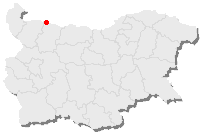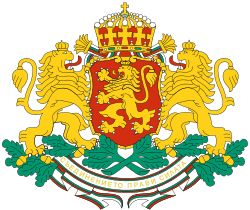Kozloduy
| Kozloduy Козлодуй | |
|---|---|
| Town | |
 Location of Kozloduy in Bulgaria | |
| Coordinates: 43°47′0″N 23°44′0″E / 43.78333°N 23.73333°ECoordinates: 43°47′0″N 23°44′0″E / 43.78333°N 23.73333°E | |
| Country | Bulgaria |
| Province | Vratsa Province |
| Population | |
| • Total | 13,771 |
Kozloduy (Bulgarian: Козлодуй) is a town of 13,771 inhabitants in northwest Bulgaria, located in Vratsa Province, on the Danube River. The city was liberated from Ottoman rule on 23 November 1877 by the Romanian Army under the command of the Imperial Russian Army. Kozloduy is best known for the Kozloduy Nuclear Power Plant, Bulgaria's only (as of January 2011) nuclear power plant, which is located nearby, as well as the second-largest Bulgarian Danubian island, Kozloduy Island. The city is also known for the ship Radetski, the boat in which the poet and revolutionary Hristo Botev and with 200 others crossed the Danube River in a final attempt to gather an army and liberate Bulgaria from the Ottoman Empire.
History
The earliest official data show that Kozloduy was populated in the 16th century. It is in the burial mounds where traces of a Thracian dwelling center that existed in the first millennium BC remain. Later on the big Roman roadway along the Danube passed through these places. The remains of the Roman castella (i.e. castles) Magura piatra (or Regianum[1]), Camistrum and Augusta testify to this. In this region there are three historic trenches which were later called Lomski, Ostrovski and Kozloduiski where a military garrison of Khan Asparukh was placed.
In the 18th century the settlement was marked as Kotozluk and Kozludere ("a low coomb") and later Kozloduy ("an angle of ice blocks").
On 17 May 1876 Hristo Botev's detachment landed at Kozloduy on the Radetski steamer. On 23 November 1877 the 8th cavalry regiment under Commander Alexandru Perets liberated Kozloduy from the Ottomans. This cavalry was part of the Romanian Forces under the command of the Russian Imperial Army. Construction of Kozloduy actually started with the construction of the first Nuclear Electric Power Station, which was started on 6 April 1970.
Location
The town is situated on the Danube river, which is the European Transport Corridor No.7. It is 80 km from the province center Vratsa and 200 km from the capital Sofia. The Municipality consists of 5 populated centers. The town and 4 villages - Butan, Harlets, Glojene and Kriva Bara.
Economics and business
The municipality is one of the richest in Vratsa province (after Vratsa Municipality) and has a standard of living above the average for Bulgaria. However, as in the rest of the country, it suffers from high unemployment. The town is one of the best places in Bulgaria for entrepreneurship and starting business, as many qualified personnel from other parts of Bulgaria come to Kozloduy due to the Nuclear Power Plant. Kozloduy has a strategic location near transport corridors N.7, N.5, N.8 and N.9. Two large companies, one each in the construction and electronics sectors, are based in the town.
Twin towns and Sister Cities
 Bechet, Romania[2]
Bechet, Romania[2] Bosilegrad, Serbia[3]
Bosilegrad, Serbia[3] Kalofer, Bulgaria[4]
Kalofer, Bulgaria[4] Putivl, Ukraine[5]
Putivl, Ukraine[5] Whitehaven, United Kingdom[6]
Whitehaven, United Kingdom[6]
Population
Despite a steady population decline, Kozloduy is currently the second most populous city in the Vratsa Province (Vratsa is the first) with some 13,800 residents. Bulgarians make up the largest ethnic group, followed by residents of Turkish, Roma, Russian and Romanian background. Kozloduy has also attracted foreign visitors, as many nuclear power-related seminars are held in the town.
Honors
Kozloduy Cove in Robert Island, South Shetland Islands is named after Kozloduy.
References
- ↑ An inventory of Roman Republican coin hoards and coins from Bulgaria (IRRCHBulg) by Eugeni I. Paunov,Ili︠a︡ Prokopov,2008,ISBN 8887235260,page 80
- ↑ http://www.kozloduy.bg/proekti/pobratimeni-gradove_en
- ↑ http://archive.is/20121203090224/http://www.namrb.org/filesystem.php?id=12
- ↑ http://www.karlovo.tv/kalofer-se-pobratimi-s-kozloduj-i-vratza
- ↑ http://www.mfa.gov.ua/bulgaria/bl/publication/content/38989.htm
- ↑ http://www.kozloduy.bg/proekti/pobratimeni-gradove_en
3.http://archive.is/20121203090224/http://www.namrb.org/filesystem.php?id=12
4.http://www.mfa.gov.ua/bulgaria/bl/publication/content/38989.htm
5.http://www.karlovo.tv/kalofer-se-pobratimi-s-kozloduj-i-vratza
| Wikimedia Commons has media related to Kozloduy. |
